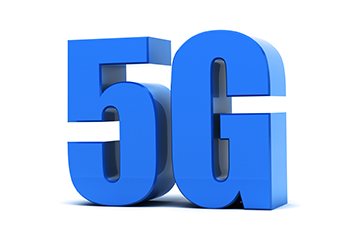5G Progresses On Multiple Fronts

MULTIPLE CITIES—Fifth-generation wireless technology is making inroads in the United States and beyond. The two biggest U.S. carriers, Verizon and AT&T, are doing marketwide deployments, while the North Carolina General Assembly is considering a bill to expedite the 5G roll-out there, and South Korea’s largest phone company intends to offer 5G services in time for the 2018 Winter Olympics.
AT&T is targeting 20 U.S. cities for 5G roll-outs this year, starting with the April 25 launch in Austin, on Samsung Galaxy S8 and S8+devices. Indianapolis will 5G’d this summer, followed by “Atlanta, Boston, Chicago, Los Angeles, Nashville, San Francisco and others” AT&T said.
AT&T said its 5G network in Austin offered “twice the speeds of our 4G LTE network,” and could be accessed by current customers there with the 5G-enabled Samsung phones. The carrier said “numerous other” 5G-enabled devices would be offered “by the end of this year.” (5G technology is not backward-compatible with the 3G and 4G LTE technology that currently prevails.)
AT&T revealed plans for the Austin 5G trial in January with a specific reference to delivery of DirecTV Now, the over-the-top version of the satellite provider’s programming. The only reference to DirecTV in the April 25 announcement was in terms of a nationwide signal reliability study that its networks provided “TV, Internet and wireless with reliability that exceeds 99 percent.”
Verizon partnered with Samsung and Cisco in what it called “the successful deployment of the first multi-vendor end-to-end 5G trial network in the field,” in Ann Arbor, Mich., earlier this month. Verizon said, “Five U.S. cities are scheduled to begin trials in the second quarter of 2017, with pilot trials in a total of 11 markets expected by the middle of the year.” Ann Arbor, along with Bernardsville, N.J.; Brockton, Mass.; Dallas, Denver, Houston, Miami, Sacramento, Seattle and Washington, D.C., were announced as “pre-commercial” 5G launch sites in February.
Verizon also recently bolstered its 5G play with a $3.1 billion purchase of Straight Path’s nationwide 39 GHz spectrum and its 28 GHz licenses. Both bands were opened last year for 5G development by the Federal Communications Commission.
Verizon said the Ann Arbor 5G fixed wireless access network “includes a 5G virtualized packet core as part of the Cisco Ultra Services Platform with Cisco Advanced Services and Samsung virtual RAN solutions (vRAN), paired with Samsung’s 5G Radio base stations and 5G home routers.” It utilizes Verizon’s own 5G spec, which the carrier developed in the absence of a global standard.
Work on a 5G standard is preliminarily under way at the International Telecommunications Union. The ITU issued a draft report outlining minimum technical requirements for IMT-2020, or 5G, radio interfaces in February. These include user data rates of 100 Mbps downlink and 50 Mbps uplink. Ars Technica has more details on the draft, which is says “will likely be approved and finalized in November this year.”
Wireless carriers around the world are moving ahead on 5G because of its capacity to support high-quality video, autonomous vehicles and, in general, the so-called “Internet of Things,” where everything from the lights, appliances, alarm systems and baby monitors to the power grid, parking meters and traffic signals—are connected via the internet.
KT Corp., formerly Korea Telecom, is on board. The carrier has pledged to launch 5G services in time for the 2018 Winter Olympic Games in PyeongChang next February, according to IEEE Spectrum. Elsewhere, phys.org. said “South Korea is planning to use the Olympic Winter Games in February 2018 to test 5G on the hundreds of thousands of spectators, providing them with access to very high-definition content or virtual reality.” Sue Marek of SDxCentral reports that KT Corp. “intends to complete the construction of a pre-standard 5G trial network by September 2017.”
Meanwhile, in North Carolina, the state general assembly is considering a bill to provide statewide permission for providers to build small 5G towers on public rights-of-way. CTIA, the wireless lobby in Washington, D.C., said providers were poised to invest $362 million to deploy 5G in Raleigh, according to WRAL. Local leaders want some say in the matter.
Also see our 5G archive:
March 20, 2017
“Wireless Providers Bullish on 5G”
March 10, 2017
“Mobile Experts Offer Positive Predictions for 5G”
March 7, 2017
“Verizon Exec: ‘Meaningful’ 5G Deployments to Start in 2018”
Feb. 23, 2017
“Verizon Aims to Deploy 5G Pilot Programs in 11 Markets by Mid-2017”
Feb. 17, 2017
“Rohde & Schwarz Does 5G Field Measurements at 28 GHz”
Feb. 16, 2017
“Ericsson Launches 5G Core System”
Feb. 7, 2107
“Report: 5G Poised to Challenge Cable, Satellite and IPTV”
Jan 24.2017
“AT&T Plans DirecTV Now Over 5G in Austin”
Nov. 11, 2016
“Facebook Does 20 Gbps Millimeter-Wave Broadband”
Sept. 6, 2016
“McAdams On: 5G Streaming”
July 14, 2016
“FCC Opens High Frequencies to Phone Companies”
July 14, 2016
“AT&T to Launch Flying Cows aka LTE Drones”
June, 20, 2016
“Wheeler Pushes for 5G Spectrum Frontier”
Nov. 18, 2015
“Ericsson: 5G Mobile Subs to Hit 150 Million by 2021”
June 3, 2015
“Unlicensed 3.5 GHz LTE Explored”
Jan. 26, 2015
“FCC Comments Urge Allocation of Spectrum Above 24 GHz for 5G And More”
Jan. 26, 2015
“Ofcom Consults on 5G Mobile Technology for the U.K. ”
Dec. 12, 2014
“Investigating Interference Between 4G LTE and Broadcast”
Dec. 5, 2014
“IBM, Ericsson Collaborate on 5G Antenna Designs”
Nov. 24, 2014
“ZTE and China Mobile Test World's First 'Pre-5G' Massive MIMO Base Station”
Nov. 24, 2014
“Millimeter Wavelength Radios, Advanced Laser Technology Provide Gigabit/second Links”
Sept. 28, 2015
“LTE-Unlicensed Spectrum Group Forms”
Sept. 22, 2014
“Xilinx, China Mobile Research Institute Partner on Virtualized 5G Network”
July 10, 2014
“Ericsson 5G Reaches 5 Gbps”
June 12, 2014
“Researchers Develop Innovative Solutions for 60 GHz 5G networks”
June 6, 2014
“Pasternack Releases New Line of Millimeter Wave Antennas
May 19, 2014
“5G Wireless Trial Planned in 15 GHz Spectrum”
May 20, 2013
“More Details Emerge on Samsung 28 GHz 5G Wireless Technology”
The technology works at 28 GHz and uses a 64-element adaptive antenna array to provide data rates of 1.056 Gbps over distances up to 2 km.
May 20, 2013
“Samsung develops adaptive array transceiver for 5G cellular communications”
Sept. 20, 2012
“FCC to implement PCAST recommendation for 3.5GHz band”
Nov. 20, 2009
“WCAI looks to 3.65 GHz band for wireless broadband”
Oct. 24, 2008
“Researchers in Singapore Develop New Antenna for Millimeter Bands”
March 8, 2005
“FCC Modifies Millimeter Band Rules”
Feb. 8, 2005
“New Process for Millimeter Band Link Registration”
Oct. May 2004
“FCC Designates Database Managers for Millimeter Wave Spectrum”
Feb. 17, 2004
“Millimeter Wave Spectrum Reallocated”
Nov. 10, 2003
“FCC Releases R&O with Service Rules for Millimeter Bands”
Oct. 21, 2003
“FCC Sets Rules for Millimeter Wave Bands”
Get the TV Tech Newsletter
The professional video industry's #1 source for news, trends and product and tech information. Sign up below.
